| Washington-Slagbaai National Park
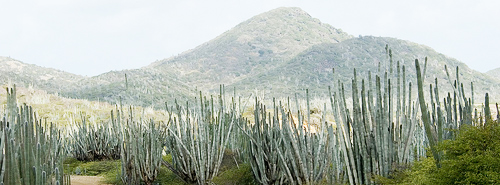

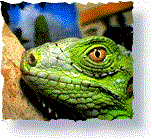 This pristine 13,500 acre natural park offers an excellent introduction to the landscape and vegetation of Bonaire. Covering almost one-fifth of the island, the park offers hills with scenic vistas, vast saline plains, beaches and trees filled with exotic birds. Animal life includes wild donkeys, goats and iguanas. There are also spots that offer excellent snorkeling and diving. Depending on the amount of time visitors have to explore, they can choose different routes through the park. This pristine 13,500 acre natural park offers an excellent introduction to the landscape and vegetation of Bonaire. Covering almost one-fifth of the island, the park offers hills with scenic vistas, vast saline plains, beaches and trees filled with exotic birds. Animal life includes wild donkeys, goats and iguanas. There are also spots that offer excellent snorkeling and diving. Depending on the amount of time visitors have to explore, they can choose different routes through the park.
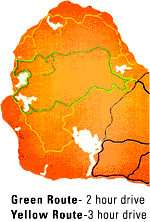 There are two driving trails, the shorter, green route of 28 km (17 miles), which takes about two hours to travel, and the longer, yellow route of 45 km (28 miles), which takes about four hours. These are rugged dirt roads, and only four-wheel drive vehicles are recommended. In the center of the park, there is also a walking trail up to Brandaris, the highest hill of Bonaire which offers a wonderful view of the island, and only takes about three hours round trip. There are two driving trails, the shorter, green route of 28 km (17 miles), which takes about two hours to travel, and the longer, yellow route of 45 km (28 miles), which takes about four hours. These are rugged dirt roads, and only four-wheel drive vehicles are recommended. In the center of the park, there is also a walking trail up to Brandaris, the highest hill of Bonaire which offers a wonderful view of the island, and only takes about three hours round trip.
The park is open daily from 8 am to 5 pm except on official holidays.
History:
Over a century ago, two plantations stood on the present-day park. They were called Washington and Slagbaai, and their owners exported goats, cattle, aloe, salt, and charcoal produced by burning local trees. Both plantations had harbors that welcomed boats from nearby islands such as Curaçao and from as far away as Holland. The original park was formed in 1969 from the land that had been Washington plantation. In 1979, Slagbaai, whose name means slaughter because in the past the cattle would be slaughtered there, was added to form the present-day park. You can still see the fence that separated the two properties.
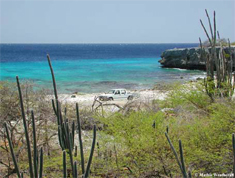 Visitors will notice a dramatic difference between the landscape of Washington, in the north, and that of Slagbaai in the south. Vegetation in Washington is sparse, consisting mainly of cacti and low shrubs, while Slagbaai is more lush. This is partially a result of Washington's soil (predominantly limestone) and the salt-laden trade winds, both of which are inhospitable to trees. Those seedlings that do take root are soon eaten by goats, which still forage freely in the northern part of the park. Slagbaai, however, is closed to goats (the fence keeps them out), thereby protecting young plants. Slagbaai's soil is also more fertile, and the land is protected from the wind by a series of hills. Visitors will notice a dramatic difference between the landscape of Washington, in the north, and that of Slagbaai in the south. Vegetation in Washington is sparse, consisting mainly of cacti and low shrubs, while Slagbaai is more lush. This is partially a result of Washington's soil (predominantly limestone) and the salt-laden trade winds, both of which are inhospitable to trees. Those seedlings that do take root are soon eaten by goats, which still forage freely in the northern part of the park. Slagbaai, however, is closed to goats (the fence keeps them out), thereby protecting young plants. Slagbaai's soil is also more fertile, and the land is protected from the wind by a series of hills.
Highlights:
Beaches
Playa Funchi, on the west coast of the island, was the harbor for Washington Plantation. The pier's stone foundations are still visible. The water is so clear that visitors standing on the low cliffs above the bay can see the colorful coral and parrotfish below. The beach has no current, so even small children can play in the water.
Boca Slagbaai, a little farther south, is ideal for swimming because there is no coral on the right side on the bay. The fine sand also makes Boca a good place for sunbathing. Buildings dating back to 1868 still stand on the beach, testifying to this harbor's historic importance. They include the home of the manager of Slagbaai plantation, a customs office and a warehouse (magasina) for storing salt.
Playa Bengè is considered one of the finest snorkeling spots on Bonaire. Swimming north from the center of the beach, divers pass over a series of coral ridges and alternating sand channels. Among the many fish in this area are jewelfish, mahogany snappers, and large tiger groupers.
Playa Chiquitu, on the east coast near the park's entrance, is deceptive. The beach is beautiful, but the water has a strong undertow. Swimming is highly discouraged.
Saliñas
Saliñas (salt pans) are a prominent feature of Washington-Slagbaai. These stretches of salty water and mud are a reminder of the island's geological past. The surrounding ocean was once 6 meters (19 feet) higher than it is now, meaning most of present-day Bonaire was under water. As the water level dropped, salt water remained in shallow valleys that soon silted up. In the past, salt was extracted from these areas and exported. Today, the salinas are good places to see birds feeding, especially flamingoes. The size of the saliñas varies according to rainfall, but even in the dry season the ground surrounding them is wet and soft. Drivers should stick to the main roads.
Brandaris
Subi Brandaris (241 meters (790 feet)) is the highest point in the park and offers the best views of the island. A footpath leads from the parking lot up the ridge, a trip that takes about one and a half hours. The route is marked with yellow circles painted on the rocks. At the top, visitors have panoramic views of the park, with Kralendijk and the white heaps of salt from the Salt Company in the distance. Curaçao lies on the western horizon. On especially clear days, even Venezuela is visible.
Birdwatching
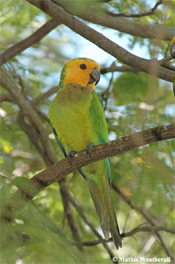 Pos Mangel ("sweet well") is one of the few places in the park where water is always available. It is therefore a good spot to watch birds as they stop for a drink. Most species will flee any noise, so visitors should park their cars and sneak to the well. Among the species that can usually be seen are bananaquits, mockingbirds, doves, and even the shy local pigeons. This is also a good place to see the colorful green lora, the local name for the Caribbean parrot. This bird is now unfortunately endangered due to its popularity as a pet. Pos Mangel ("sweet well") is one of the few places in the park where water is always available. It is therefore a good spot to watch birds as they stop for a drink. Most species will flee any noise, so visitors should park their cars and sneak to the well. Among the species that can usually be seen are bananaquits, mockingbirds, doves, and even the shy local pigeons. This is also a good place to see the colorful green lora, the local name for the Caribbean parrot. This bird is now unfortunately endangered due to its popularity as a pet.
Put Bronswinkel also contains fresh water year-round; therefore it is another popular gathering place for birds. Patient (and quiet) birdwatchers will be rewarded with glimpses of rare species, such as the pearly-eyed thrasher and the yellow oriole.
Vegetation
 The most conspicuous plants in the park's northern section are cacti. The two main species, the yatu (Lemaireocereus griseus) and the kadushi (Ceres repandus), are easily distinguishable by their thorns. Those of the yatu form neat rows of rosettes, while those of the kadushi are more dense and stick out in all directions. Larger examples of the two cacti also grow in different formations. The yatu grows straight up, while the kadushi branches out. The most conspicuous plants in the park's northern section are cacti. The two main species, the yatu (Lemaireocereus griseus) and the kadushi (Ceres repandus), are easily distinguishable by their thorns. Those of the yatu form neat rows of rosettes, while those of the kadushi are more dense and stick out in all directions. Larger examples of the two cacti also grow in different formations. The yatu grows straight up, while the kadushi branches out.
Other trees in the park were of economic importance to the plantations of Washington and Slagbaai. The branches of the mesquite tree or indju (Prosopis juliflora) were burned to produce charcoal. The tree would be cut about 30 cm (12 inches) above the ground, and within five years it would grow back to its previous size. Thanks to this rapid growth and to selective cutting, Bonaire never became deforested.
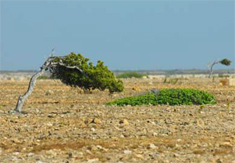 The divi-divi tree (Caesalpinia coriaria) grows pods which contain large amounts of tannin. Until the 1950's, this tannin was exported to Holland, where it was used in tanneries (which converted animal hides into leather). Visitors to the park should look for divi-divi trees on hilltops, where the constant winds have forced the trees to grow almost sideways. The divi-divi tree (Caesalpinia coriaria) grows pods which contain large amounts of tannin. Until the 1950's, this tannin was exported to Holland, where it was used in tanneries (which converted animal hides into leather). Visitors to the park should look for divi-divi trees on hilltops, where the constant winds have forced the trees to grow almost sideways.
Aloe plants (Aloe barbadensis) were also cultivated for use in the pharmaceutical industry. Visitors with sunburns can feel for themselves the soothing effect of aloe by cutting a leaf and rubbing it on the skin.
The dyewood, or Brazil wood tree (Haematoxylon brasiletto), has a distinctive, twisted shape and a deeply grooved trunk. These trees played an important role in the early history of Bonaire. In fact, the oldest known map of the Caribbean (from 1513) labels the island as "Ysla do Brasil" ("Island of the Brazil tree"). A red dye was extracted from the wood and used for coloring fabrics. The Dutch seized Bonaire from the Spanish in 1636 in part to gain access to this commercially profitable product.
The mata-piskà tree (Jacquinia barbasco) was valuable to the earliest Indian residents of the island. The tree contains chemicals that paralyze the gills of fish, but are harmless to man. The Indians would toss branches, leaves or berries into the water, wait until the anesthetized fish floated to the surface, and then gather up an easy catch.
Photo Washington Slagbaai National Park via Flickr (cc) user Paul and Jill
All other images by Mathis Weatherall.
|


